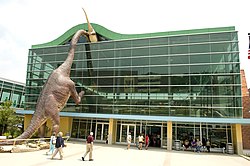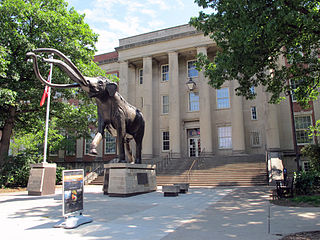
The University of Nebraska State Museum, also known as Morrill Hall, founded in 1871, is a natural history museum featuring Nebraska biodiversity, paleontology, and cultural diversity, located on the University of Nebraska–Lincoln City Campus near the corner of 14th and Vine Streets in Lincoln, Nebraska, United States. The museum houses Mueller Planetarium, a hands-on science discovery center, and the Elephant Hall, where visitors can see the world's largest articulated fossil mammoth among the collection of fossil elephants. Also featured are interactive paleontology exhibits, a dinosaur gallery, ancient life and evolution exhibits, wildlife dioramas, gems and minerals, American Indian and African exhibits, and a temporary exhibit gallery featuring rotating displays on diverse topics including photography, quilts and fine arts.

The Museum of Science (MoS) is a nature and science museum and indoor zoological establishment located in Science Park, a plot of land in Boston and Cambridge, Massachusetts, spanning the Charles River. Along with over 700 interactive exhibits, the museum features a number of live and interactive presentations throughout the building each day, along with scheduled film showings at the Charles Hayden Planetarium and the Mugar Omni Theater. Additionally, the Museum of Science is an accredited member of the Association of Zoos and Aquariums (AZA), being home to over 100 animals, many of which the museum gained after they were surrendered, confiscated, rescued or rehabilitated.

COSI, officially the Center of Science and Industry, is a science museum and research center in Columbus, Ohio. COSI was opened to the public on 29 March 1964 and remained there for 35 years. In 1999, COSI was moved to a 320,000-square-foot (30,000 m2) facility, designed by Japanese architect Arata Isozaki along a bend in the Scioto River in the Franklinton neighborhood. COSI features more than 300 interactive exhibits throughout themed exhibition areas.
Lilly Endowment Inc., headquartered in Indianapolis, Indiana, is one of the world's largest private philanthropic foundations and among the largest endowments in the United States. It was founded in 1937 by Josiah K. Lilly Sr. and his sons, Eli Jr. and Josiah Jr. (Joe), with an initial gift of Eli Lilly and Company stock valued at $280,000 USD. As of 2020, its total assets were worth $21 billion.

Conner Prairie is a living history museum in Fishers, Indiana, United States, which preserves the William Conner home. The home is listed on the National Register of Historic Places, and the museum recreates 19th-century life along the White River. The museum also hosts several programs and events, including outdoor performances by the Indianapolis Symphony Orchestra and summer camps.

The Indiana State Museum is a museum located in downtown Indianapolis, Indiana, United States. The museum houses exhibits on the science, art, culture, and history of Indiana from prehistoric times to the present day.
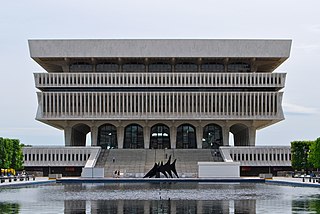
The New York State Museum is a research-backed institution in Albany, New York, United States. It is located on Madison Avenue, attached to the south side of the Empire State Plaza, facing onto the plaza and towards the New York State Capitol. The museum houses art, artifacts, and ecofacts that reflect New York’s cultural, natural, and geological development. Operated by the New York State Education Department's Office of Cultural Education, it is the oldest and largest state museum in the US. Formerly located in the State Education Building, the museum now occupies the first four floors of the Cultural Education Center, a ten-story, 1,500,000-square-foot (140,000 m2) building that also houses the New York State Archives and New York State Library.
The North Carolina Museum of Natural Sciences (NCMNS) is a museum in Raleigh, North Carolina. The museum is the oldest in the state.

The New Mexico Museum of Natural History and Science is a natural history and science museum in Albuquerque, New Mexico near Old Town Albuquerque. The Museum was founded in 1986. It operates as a public revenue facility of the New Mexico Department of Cultural Affairs.

The Museum of the Earth is a natural history museum located in Ithaca, New York. The museum was opened in 2003 as part of the Paleontological Research Institution (PRI), an independent organization pursuing research and education in the history of the Earth and its life. Both PRI and the Museum of the Earth are formally affiliated with Cornell University. The Museum of the Earth is home to Earth science exhibits and science-related art displays with a focus on the concurrent evolution of the Earth and life.
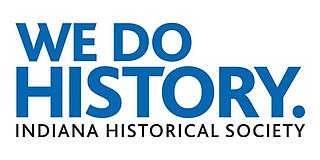
The Indiana Historical Society (IHS) is one of the United States' oldest and largest historical societies. It describes itself as "Indiana's Storyteller".

The Orlando Science Center (OSC) is a private science museum located in Orlando, Florida. Its purposes are to provide experience-based opportunities for learning about science and technology and to promote public understanding of science.
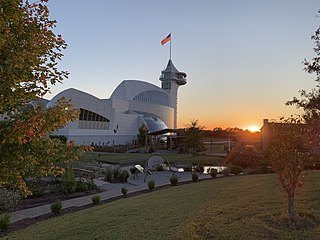
Discovery Park of America is a museum and heritage park located just outside the boundary of Union City, Tennessee. The park sits on 50 acres (20 ha) of land off of Everett Boulevard, near U.S. Route 51 and the proposed Interstate 69. It features exhibits and activities on local history, nature, military history, art and science.

Broad Ripple Park Carousel is an antique carousel in The Children's Museum of Indianapolis. It was installed in 1917 at an amusement park near the White River in Indianapolis, Indiana, where it remained until the building housing it collapsed in 1956. The ride's mechanism was destroyed, but the animals were relatively unscathed and put into storage by the park's owners, the Indianapolis Department of Parks and Recreation. The animals were carved by the Dentzel Carousel Company some time before 1900 but were assembled by the William F. Mangels carousel company, which also supplied the engine powering the ride.

The Rotunda Museum is one of the oldest purpose-built museums still in use in the United Kingdom. The curved grade II* listed building was constructed in 1829 as one of the country's first purpose-built museums. Situated in the English coastal resort of Scarborough, North Yorkshire, it houses one of the foremost collections of Jurassic geology on the Yorkshire Coast.
John J. Lanzendorf was an American hairstylist who amassed one of the world's largest collections of dinosaur-themed artwork. The collection is now owned by the Children's Museum of Indianapolis.

The Virginia Air and Space Science Center is a museum and educational facility in Hampton, Virginia that also serves as the visitors center for NASA's Langley Research Center and Langley Air Force Base. The museum also features an IMAX digital theater and offers summer aeronautic- and space-themed camps for children.
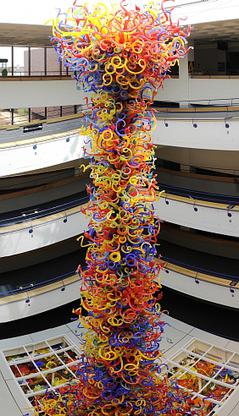
Fireworks of Glass Tower and Ceiling, also known as Fireworks of Glass, is a blown glass sculpture installation in the permanent collection of The Children's Museum of Indianapolis located in Indianapolis, Indiana, United States of America. The tower sits on a glass base, a pergola ceiling, and rises through the center of the museum's spiraling ramp system. Created by Dale Chihuly in 2006, it is his second-largest permanently installed glass sculpture. Beneath the tower is an accompanying exhibit that describes the sculpture and the process by which it was made. The tower and pergola ceiling are two distinct accessioned objects in the Children's Museum's collection.

QRpedia is a mobile Web-based system which uses QR codes to deliver Wikipedia articles to users, in their preferred language. A typical use is on museum labels, linking to Wikipedia articles about the exhibited object. QR codes can easily be generated to link directly to any Uniform Resource Identifier (URI), but the QRpedia system adds further functionality. It is owned and operated by a subsidiary of Wikimedia UK (WMUK).
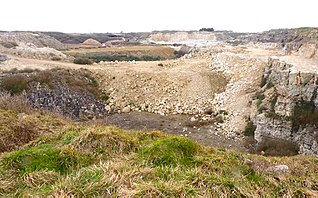
Jurassica was a planned visitor attraction in a disused quarry on the Isle of Portland, near Weymouth in Dorset, southern England. It was based on the Jurassic Coast, a World Heritage Site, and as a subterranean geological park, would have largely presented the prehistoric world. The attraction's location was chosen as Yeolands Quarry, a now disused quarry that was operational until the 21st century by Portland Stone Ltd. The quarry is 36 metres (120 ft) deep, 90 metres (300 ft) wide, and is on the eastern side of the island just south of The Grove village.

